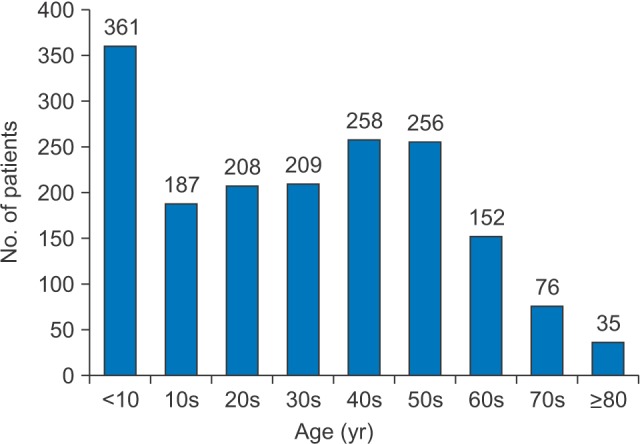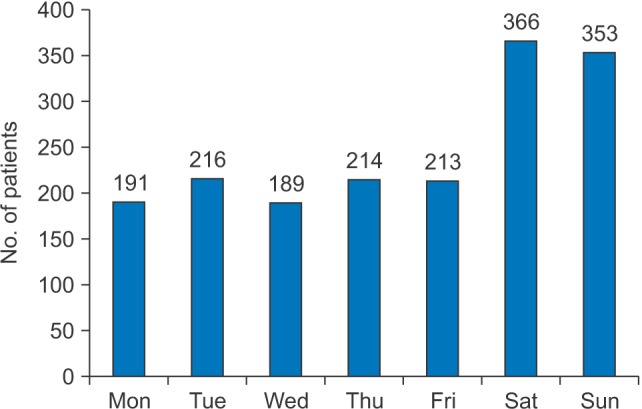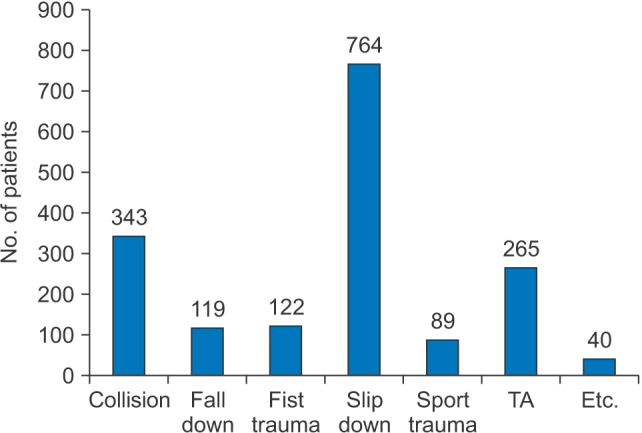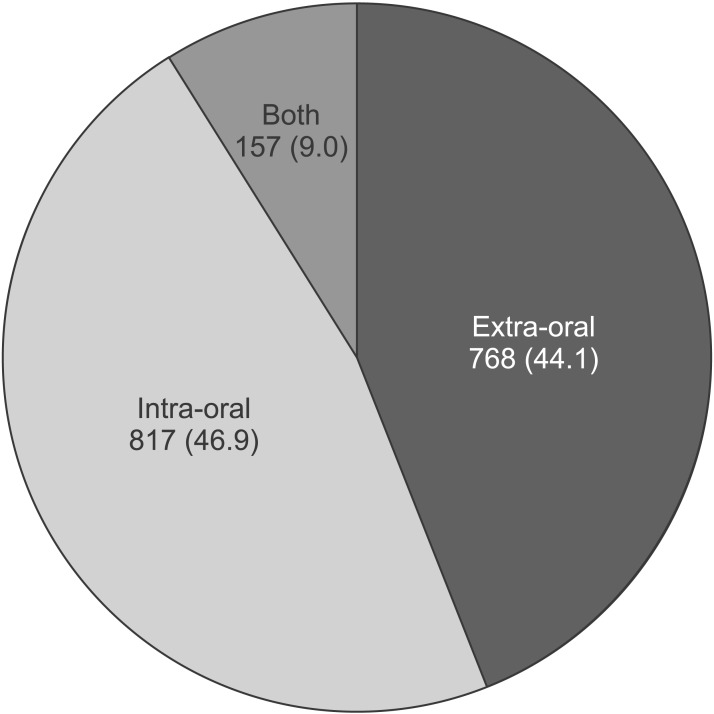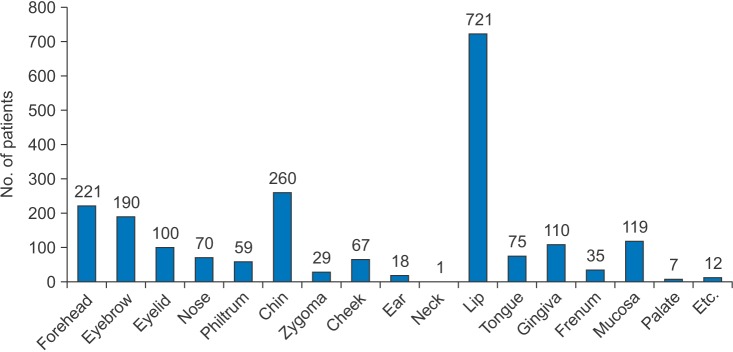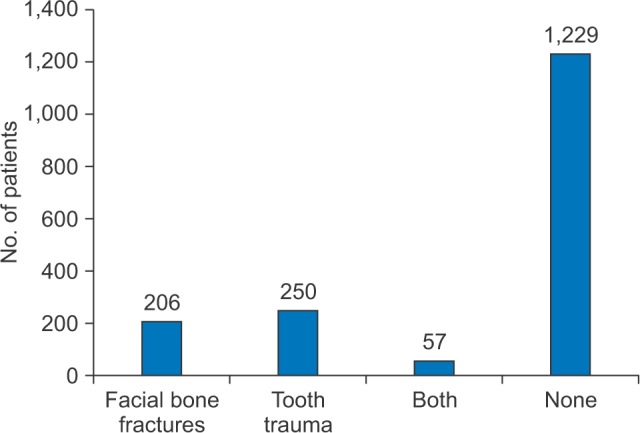J Korean Assoc Oral Maxillofac Surg.
2015 Oct;41(5):246-250. 10.5125/jkaoms.2015.41.5.246.
A clinical study of emergency room visits for oral and maxillofacial lacerations
- Affiliations
-
- 1Department of Oral and Maxillofacial Surgery, School of Dentistry, Pusan National University, Yangsan, Korea. omsljy@pusan.ac.kr
- KMID: 2070438
- DOI: http://doi.org/10.5125/jkaoms.2015.41.5.246
Abstract
OBJECTIVES
This study investigated patients with oral and maxillofacial lacerations who visited the emergency room over a three-year period in an effort to determine the optimal treatment for these injuries.
MATERIALS AND METHODS
This study examined 1,742 patients with oral and maxillofacial lacerations with 2,014 different laceration locations who visited the emergency room of Pusan National University Hospital (Busan, Korea) over three years, from January 2011 to December 2013. Patients were classified by sex, age, visit day, cause of injury, injury site, and the presence or absence of soft tissue and tooth injuries.
RESULTS
The male to female ratio was 2.50:1. Patients under 10 years old were seen most frequently. Most emergency room visits were on weekends. Among intra-oral lacerations, the lip area was the most vulnerable site; among extra-oral lacerations, the chin area was most frequently injured. The most frequent etiology was a slip down. Most lacerations occurred without bone fracture or tooth damage.
CONCLUSION
Laceration may differ in large part as compared with the fracture. Therefore, it is necessary to continue collecting data on oral and maxillofacial lacerations to establish optimal emergency room diagnosis and treatment strategies.
MeSH Terms
Figure
Reference
-
1. Huelke DF, Compton CP. Facial injuries in automobile crashes. J Oral Maxillofac Surg. 1983; 41:241–244. PMID: 6572693.
Article2. Hausamen JE. The scientific development of maxillofacial surgery in the 20th century and an outlook into the future. J Craniomaxillofac Surg. 2001; 29:2–21. PMID: 11467489.
Article3. Ong TK, Dudley M. Craniofacial trauma presenting at an adult accident and emergency department with an emphasis on soft tissue injuries. Injury. 1999; 30:357–363. PMID: 10505131.
Article4. Singer AJ, Thode HC Jr, Hollander JE. National trends in ED lacerations between 1992 and 2002. Am J Emerg Med. 2006; 24:183–188. PMID: 16490648.
Article5. Hollander JE, Singer AJ, Valentine S, Henry MC. Wound registry: development and validation. Ann Emerg Med. 1995; 25:675–685. PMID: 7741347.
Article6. Kim JR, Chung IK, Yang DK, Park BW. A clinical study on the emergency patients of oral and maxillofacial surgery during recent 5 years. J Korean Assoc Maxillofac Plast Reconstr Surg. 2001; 23:155–162.7. Cho KS, Kim KY, Lee SH, Park HJ, So KS, Cho YK, et al. A clinical study on oral & maxillofacial patients visiting Chonnam Univ-hospitial emergency room. J Korean Assoc Maxillofac Plast Reconstr Surg. 1997; 19:435–446.8. Jang CS, Lee CY, Kim JW, Yim JH, Kim JY, Kim YH, et al. A clinical study on the dental emergency patients visiting an University Hospital emergency room. J Korean Assoc Oral Maxillofac Surg. 2011; 37:439–447.
Article9. Kim HG, Son YH, Chung IK. Facial bone fracture patients visiting Pusan National University Hospital in Busan and Yangsan: trends and risks. Maxillofac Plast Reconstr Surg. 2014; 36:140–145.
Article10. Kim SH, Kim DY, Baek JS, Jung TY, Park SJ. Characteristics of dental emergency patients at Busan Paik Hospital. J Korean Assoc Maxillofac Plast Reconstr Surg. 2012; 34:58–64.11. Hill CM, Burford K, Martin A, Thomas DW. A one-year review of maxillofacial sports injuries treated at an accident and emergency department. Br J Oral Maxillofac Surg. 1998; 36:44–47. PMID: 9578256.
Article
- Full Text Links
- Actions
-
Cited
- CITED
-
- Close
- Share
- Similar articles
-
- A retrospective analysis of emergency room visits of oral and maxillofacial surgery patients in a tertiary care hospital
- A CLINICAL STUDY ON ORAL & MAXILLOFACIAL PATIENTS VISITING CHONNAM UNIV-HOSPITIAL EMERGENCY ROOM
- Clinical Study of Hospital Mortality in Patients Visiting the Emergency Room at Nighttime in a City of Korea
- Analysis of Patients with Facial Lacerations Repaired in the Emergency Room of a Provincial Hospital
- Stastical studies on pediatric emergency room patients

